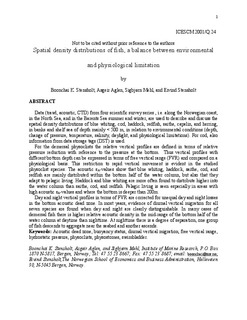| dc.description.abstract | Data (trawl, acoustic, CTD) from four scientific survey series , i.e. along the Norwegian coast,
in the North Sea, and in the Barents Sea summer and winter, are used to describe and discuss the
spatial density distributions of blue whiting, cod, haddock, redfish, saithe, capelin, and herring,
in banks and shelf sea of depth mainly < 500 m, in relation to environmental conditions (depth,
change of pressure, temperature, salinity, daylight, and physiological limitations). For cod, also
information from data storage tags (DST) is used.
For the demersal physoclists the relative vertical profiles are defined in terms of relative
pressure reduction with reference to the pressure at the bottom. Thus vertical profiles with
different bottom depth can be expressed in terms of free vertical range (FVR) and compared on a
physiological basis. This restriction to rapid vertical movement is evident in the studied
physoclist species. The acoustic sA-values show that blue whiting, haddock, saithe, cod, and
redfish are mainly distributed within the bottom half of the water column, but also that they
adapt to pelagic living. Haddock and blue whiting are more often found to distribute higher into
the water column than saithe, cod, and redfish. Pelagic living is seen especially in areas with
high acoustic sA-values and where the bottom is deeper than 200m.
Day and night vertical profiles in terms of FVR are corrected for unequal day and night losses
in the bottom acoustic dead zone. In most years, evidence of diurnal vertical migration for all
seven species are found when day and night are clearly distinguishable. In many cases of
demersal fish there is higher relative acoustic density in the mid-range of the bottom half of the
water column at daytime than nighttime. At nighttime there is a degree of separation, one group
of fish descends to aggregate near the seabed and another ascends. | en |
